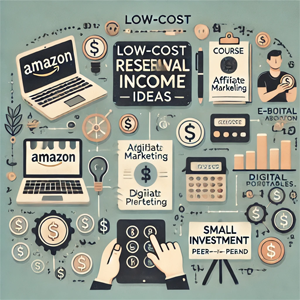Residual Income Ideas You Can Start with Little to No Money
 Generating residual income can be a game-changer for financial stability, especially when you start with minimal upfront investment. Here’s a guide to five low-cost residual income ideas, each with a real-life case study to showcase how others have successfully implemented these strategies. Whether you’re a content creator, a beginner investor, or someone looking to leverage your skills, these ideas offer pathways to start earning without heavy financial commitment.
Generating residual income can be a game-changer for financial stability, especially when you start with minimal upfront investment. Here’s a guide to five low-cost residual income ideas, each with a real-life case study to showcase how others have successfully implemented these strategies. Whether you’re a content creator, a beginner investor, or someone looking to leverage your skills, these ideas offer pathways to start earning without heavy financial commitment.
1. Publishing E-books on Amazon
Publishing e-books on Amazon Kindle Direct Publishing (KDP) is an accessible way to generate residual income with no upfront cost. With Amazon’s global reach, you can tap into a vast audience and continue to earn royalties on each sale.
Case Study - Sarah’s Success with E-book Publishing: Sarah, a health and wellness coach, published an e-book on Amazon titled “Healthy Living for Busy People.” She wrote the book over a few weekends, focusing on simple wellness practices. By promoting her e-book on social media, she reached her target audience of health-conscious individuals. Priced at $4.99, her book now earns her an average of $300 monthly in royalties. With the initial effort of writing and publishing, Sarah enjoys ongoing earnings without needing further investment.
Getting Started Tip: Choose a topic you’re passionate about and knowledgeable in. Use free resources like Canva to design the cover and take advantage of Amazon’s built-in tools to format your e-book.
2. Affiliate Marketing through Blogging or Social Media
Affiliate marketing involves promoting other people’s products through a blog or social media, earning a commission on each sale generated through your referral. Platforms like Amazon Associates and ShareASale allow you to start without any upfront cost.
Case Study - Jake’s Affiliate Marketing Success through Blogging: Jake, a tech enthusiast, started a blog reviewing budget-friendly gadgets and electronics. By joining the Amazon Associates program, he included affiliate links in his product reviews. Within a few months, he built a small but dedicated readership, earning about $200 per month in affiliate commissions. Jake now plans to expand his blog, increasing his potential for passive income over time.
Getting Started Tip: Focus on a niche to build a loyal audience. To maximize SEO and reach, write detailed product reviews or list articles like “Top 10 Budget Gadgets” to drive traffic to your affiliate links.
3. Creating an Online Course
If you have expertise in a specific area, creating an online course is a low-cost way to generate residual income. Platforms like Udemy, Skillshare, and Teachable allow you to publish and sell courses with minimal setup costs.
Case Study - Maria’s Course on Interior Design Basics: Maria, an interior designer, created a course on basic design principles for small spaces. She spent time recording videos and creating downloadable resources. By pricing her course affordably, Maria attracted over 200 students in her first month, generating around $1,000 in residual income. She only needs to update the course occasionally, allowing her to continue earning with minimal ongoing work.
Getting Started Tip: Start with a simple course outline. Record with your phone or laptop to keep costs low and focus on creating value for your target audience.
4. Selling Printables and Digital Downloads
Printables, like planners, calendars, or educational worksheets, are easy to create and can be sold on platforms like Etsy or Gumroad. Once designed, they can be sold repeatedly with little to no ongoing effort, making them a residual income stream with minimal maintenance.
Case Study - Emily’s Success with Printables on Etsy: Emily, a teacher, designed printable educational worksheets for kids and listed them on Etsy. She promoted her store on Pinterest, which attracted parents and teachers looking for affordable resources. Within the first three months, her store averaged $150 monthly, and her earnings continue to grow as her designs gain more visibility.
Getting Started Tip: Use free design tools like Canva to create your printables. Focus on a niche that interests you—whether it’s organization, education, or self-care—and create designs that cater to that audience.
5. Peer-to-Peer Lending
Peer-to-peer (P2P) lending allows you to lend small amounts of money to individuals or small businesses through platforms like LendingClub or Prosper. Although it requires an initial investment, it often allows you to start with as little as $25 per loan, spreading your risk across multiple loans.
Case Study - Mark’s P2P Lending Strategy: Mark, a college student, wanted a way to earn residual income without a large upfront investment. He began with $100 and diversified across four different loans on a P2P platform. By choosing lower-risk borrowers, Mark earns about 5% interest annually. His earnings are modest but consistent, and he plans to reinvest his profits over time to grow his residual income.
Getting Started Tip: Diversify your loans to minimize risk, and choose borrowers with solid credit ratings if you’re starting with a small amount. Many P2P platforms offer tools to automate the reinvestment of earnings.
Conclusion
These five low-cost residual income ideas allow you to start earning with minimal investment. From publishing e-books and creating online courses to affiliate marketing, printables, and P2P lending, there are numerous ways to generate income streams with little to no upfront cost. By leveraging your existing skills and interests, you can create a sustainable income stream that grows over time.
Residual Income Planner Related Articles
- 5 Low-Risk Residual Income Investments for Beginners
- Ebook Publishing Residual Income: Pros, Cons, and Tips for Success
- How to Build a Residual Income Plan from Scratch: A Step-by-Step Guide
- How to Build Wealth with Residual Income in Your 20s, 30s, and Beyond
- How to Diversify Your Residual Income Streams and Maximize Earnings
- Passive Income vs. Residual Income: What’s the Difference and Which is Better?
- Residual Income for Retirees: How to Supplement Your Retirement Fund
- Residual Income Ideas You Can Start with Little to No Money
- The Ultimate Guide to Earning Residual Income with Affiliate Marketing
- Top 10 Residual Income Streams You Can Start Today for Financial Freedom
5 Low-Risk Residual Income Investments for Beginners
 Residual income can be a great way to generate ongoing earnings with low risk, especially for those new to investing. Low-risk residual income investments offer the chance to grow wealth steadily without significant volatility. Here are five beginner-friendly options, including real-life case studies to show how others have successfully used these strategies to build financial security.
Residual income can be a great way to generate ongoing earnings with low risk, especially for those new to investing. Low-risk residual income investments offer the chance to grow wealth steadily without significant volatility. Here are five beginner-friendly options, including real-life case studies to show how others have successfully used these strategies to build financial security.
1. Dividend-Paying Stocks
Dividend-paying stocks are shares of companies that pay out a portion of their profits to shareholders. This form of residual income can be an ideal choice for beginners due to its stability, especially when investing in established companies with consistent dividend histories.
Case Study - Rachel’s Dividend Investment for Reliable Income: Rachel, a school teacher, started investing in dividend stocks five years ago to supplement her income. She focused on blue-chip companies known for their stability, such as Procter & Gamble and Johnson & Johnson. With an initial investment of $2,000, Rachel now receives around $300 annually in dividends. By reinvesting her earnings, she’s growing her portfolio steadily and building her income stream without a high level of risk.
Why It’s Low-Risk: Dividend-paying stocks from established companies are generally stable, especially if you diversify across industries. Regular dividends provide a reliable income source, and reinvesting dividends can lead to long-term growth.
2. Real Estate Investment Trusts (REITs)
REITs are companies that own, operate, or finance real estate that produces income. By investing in REITs, you can earn income from real estate without directly owning or managing properties. REITs distribute a large portion of their profits as dividends, making them an accessible option for generating residual income.
Case Study - Ben’s Investment in REITs for Passive Income: Ben, a graphic designer, wanted to invest in real estate but didn’t have enough capital for a down payment. Instead, he invested $1,500 in a REIT that focuses on residential properties. His REIT investment pays quarterly dividends, providing him with around $200 a year. Ben reinvests these dividends and plans to add to his investment whenever he can. Over time, he’s grown his income without property management headaches.
Why It’s Low-Risk: REITs are regulated to distribute at least 90% of their income to shareholders, ensuring regular payouts. They also offer diversification across real estate sectors (e.g., retail, residential, commercial), which helps reduce risk.
3. High-Yield Savings Accounts or Certificates of Deposit (CDs)
High-yield savings accounts and CDs are savings products that earn interest, offering a low-risk way to grow your funds. While they may not have the same high returns as stocks or real estate, they provide a predictable residual income source with virtually no risk to the principal amount.
Case Study - Emily’s CDs for Secure Savings Growth: Emily, a recent college graduate, wanted a safe place to park her savings while earning interest. She invested $5,000 in a 12-month CD with a 3% interest rate. At the end of the year, Emily earned $150 in interest. She appreciates the predictability and plans to reinvest in a longer-term CD for slightly higher rates. Her CD investment provides security, and she earns interest without market volatility.
Why It’s Low-Risk: High-yield savings accounts and CDs are insured by the FDIC up to $250,000, making them one of the safest ways to earn residual income. They are ideal for conservative investors seeking steady, reliable returns without exposure to market fluctuations.
4. Peer-to-Peer Lending
Peer-to-peer (P2P) lending allows you to lend money to individuals or small businesses through online platforms in exchange for interest payments. Many platforms let you spread your investments across multiple loans, reducing your risk if some loans default.
Case Study - Mark’s Diversified P2P Lending Portfolio: Mark, a freelance writer, decided to try P2P lending to generate a little extra income. With a $1,000 investment, he diversified across 20 loans on a P2P platform. Although a few borrowers defaulted, Mark still earns around 5% net returns, resulting in approximately $50 per year. He uses his earnings to fund additional loans, creating a cycle of residual income.
Why It’s Low-Risk: P2P lending can be low-risk if you diversify your loans and choose lower-risk borrowers. Platforms often rate borrowers, allowing you to select lower-risk individuals and reduce the chances of default.
5. Treasury Bonds
Treasury bonds (T-bonds) are government-backed securities that pay interest every six months. They are one of the safest investments, as they’re backed by the U.S. government, making them a reliable residual income source for beginners looking for low-risk options.
Case Study - Claire’s Investment in Treasury Bonds for Stability: Claire, a nurse, wanted a stable, low-risk investment. She invested $2,500 in a 10-year T-bond with a fixed interest rate of 2.5%. She receives $62.50 in interest every six months, providing her with predictable income. While her returns aren’t as high as some other investments, she values the stability and low risk associated with T-bonds.
Why It’s Low-Risk: Treasury bonds are backed by the U.S. government, making them one of the safest investment options available. They offer predictable income and are ideal for conservative investors looking to balance risk and return.
Conclusion
For beginners, these five low-risk residual income options provide a range of ways to build income without significant exposure to risk. Dividend stocks, REITs, high-yield savings, P2P lending, and treasury bonds each have unique benefits that cater to various financial goals. By understanding your risk tolerance and financial goals, you can choose the right residual income source and start building a steady income stream with confidence.
Residual Income Planner Related Articles
- 5 Low-Risk Residual Income Investments for Beginners
- Ebook Publishing Residual Income: Pros, Cons, and Tips for Success
- How to Build a Residual Income Plan from Scratch: A Step-by-Step Guide
- How to Build Wealth with Residual Income in Your 20s, 30s, and Beyond
- How to Diversify Your Residual Income Streams and Maximize Earnings
- Passive Income vs. Residual Income: What’s the Difference and Which is Better?
- Residual Income for Retirees: How to Supplement Your Retirement Fund
- Residual Income Ideas You Can Start with Little to No Money
- The Ultimate Guide to Earning Residual Income with Affiliate Marketing
- Top 10 Residual Income Streams You Can Start Today for Financial Freedom
Passive Income vs. Residual Income: What’s the Difference and Which is Better?
 Both passive income and residual income offer opportunities to earn money with minimal active effort, but they’re not the same. While often used interchangeably, passive and residual income involve different methods, financial goals, and levels of involvement. Here, we’ll break down the distinctions, highlight the pros and cons of each, and examine case studies to illustrate how real people use these income types for financial freedom.
Both passive income and residual income offer opportunities to earn money with minimal active effort, but they’re not the same. While often used interchangeably, passive and residual income involve different methods, financial goals, and levels of involvement. Here, we’ll break down the distinctions, highlight the pros and cons of each, and examine case studies to illustrate how real people use these income types for financial freedom.
Understanding Passive Income
Passive income is income generated from activities that require little to no active involvement after the initial setup. It usually involves a financial investment, time commitment, or creation effort upfront, but once established, it generates cash flow with minimal management.
Examples of Passive Income: Dividend-paying stocks, rental properties, peer-to-peer lending, income from royalties
Case Study - David’s Stock Dividend Portfolio: David, a software developer, wanted to grow his wealth outside of his day job. He started investing in dividend-paying stocks from companies like Home Depot Inc., and JPMorgan Chase, building a portfolio worth $20,000 over several years. By reinvesting dividends, his portfolio now generates about $200 per month, which he plans to grow steadily. Because dividend stocks don’t require hands-on management, they offer David a truly passive income source with little ongoing effort.
Pros of Passive Income: Low ongoing involvement after setup, scalable with reinvestment and time, reliable when investments are diversified
Cons of Passive Income: Requires upfront investment or time, income can fluctuate with market changes (e.g., stock dividends), some passive streams, like real estate, may require periodic attention
Passive income is ideal for those looking to grow wealth over time with minimal effort and for investors who are comfortable with upfront costs in exchange for long-term rewards.
Understanding Residual Income
Residual income, while similar to passive income, refers to income earned after the initial effort or investment but typically requires ongoing maintenance to keep the income flowing. Many residual income sources involve activities where initial work brings consistent payouts over time, but they may need periodic updates, marketing, or management.
Examples of Residual Income: Book royalties, membership sites, online courses, affiliate marketing
Case Study - Sarah’s Online Course Success: Sarah, a digital marketing expert, created a comprehensive course on SEO basics. She hosted the course on an online platform and promoted it via her social media. Her course generates around $1,000 each month, but she occasionally updates the content to keep it relevant and promotes it to reach new students. While Sarah’s course provides steady income, it requires occasional management, making it a residual income stream rather than fully passive.
Pros of Residual Income: Often faster to set up than passive streams like investments, can be more lucrative with the right audience, flexible with potential for multiple income sources (e.g., several courses or affiliate partnerships)
Cons of Residual Income: Requires occasional maintenance (content updates, customer support), income may taper off if engagement declines, more hands-on than traditional passive income streams
Residual income is great for entrepreneurs or content creators who want to use their skills to earn ongoing income with manageable upkeep.
Key Differences Between Passive and Residual Income
Level of Maintenance: Passive income requires less active involvement once established. In contrast, residual income often needs periodic management to sustain earnings.
Initial Investment: Passive income usually demands a financial investment (like purchasing stocks or property), while residual income can be generated through work (like writing a book or creating a course) rather than capital.
Income Stability: Passive income from investments like dividends is typically more predictable, while residual income can vary depending on market trends or audience engagement.
Scalable Opportunities: Both types of income can be scaled, but passive income is more scalable through reinvestment, while residual income often relies on adding more products or expanding an audience.
Passive Income vs. Residual Income: Which is Better?
The “better” option depends on your financial goals, time availability, and risk tolerance. Here’s a quick guide to help you decide.
Choose Passive Income if:
- You have upfront capital to invest
- You prefer low maintenance after the initial setup
- You’re interested in long-term growth and stable returns
Case Study - Tom’s Rental Property Investment: Tom, a small business owner, invested in a rental property to generate passive income. After purchasing a condo in a high-demand area, he hired a property management company to handle tenant relationships and maintenance, making his involvement minimal. His rental property now generates a steady $1,200 monthly income, ideal for Tom’s preference for a low-maintenance, reliable investment.
Choose Residual Income if:
- You have a skill or knowledge base you can monetize
- You’re willing to maintain or update content as needed
- You want to earn income faster without significant upfront investment
Case Study - Lisa’s Affiliate Marketing Business: Lisa, a beauty blogger, leveraged her blog to earn through affiliate partnerships with makeup brands. She reviews products and includes affiliate links, earning a commission for each sale. By posting weekly, she keeps her audience engaged and ensures a steady income. Although Lisa spends time maintaining her blog, it generates around $800 monthly, making it a highly manageable and rewarding residual income source.
Combining Passive and Residual Income for Financial Security
Many successful earners combine both passive and residual income streams to diversify their earnings. Combining these can create a stable, multi-faceted income plan that provides financial security.
Case Study - Emma’s Blended Approach: Emma, an educator, started with a blog about personal finance, creating residual income through affiliate marketing. She then used her blog earnings to invest in dividend-paying stocks, building a passive income portfolio. By combining both income types, Emma has built a sustainable financial safety net. Her blog generates around $1,500 per month in residual income, while her stock portfolio adds another $300 in passive income.
Emma’s approach demonstrates the benefits of combining passive and residual income to reduce reliance on any single stream. This strategy allows you to earn faster with residual income while building wealth and security with passive income.
Conclusion
Passive and residual income each have unique benefits, but neither is universally better. Passive income is ideal for those looking to invest capital and grow wealth with minimal involvement, while residual income suits creators who are willing to do periodic work for ongoing earnings. Combining both types offers financial flexibility, security, and multiple income sources—key ingredients for long-term financial independence.
Residual Income Planner Related Articles
- 5 Low-Risk Residual Income Investments for Beginners
- Ebook Publishing Residual Income: Pros, Cons, and Tips for Success
- How to Build a Residual Income Plan from Scratch: A Step-by-Step Guide
- How to Build Wealth with Residual Income in Your 20s, 30s, and Beyond
- How to Diversify Your Residual Income Streams and Maximize Earnings
- Passive Income vs. Residual Income: What’s the Difference and Which is Better?
- Residual Income for Retirees: How to Supplement Your Retirement Fund
- Residual Income Ideas You Can Start with Little to No Money
- The Ultimate Guide to Earning Residual Income with Affiliate Marketing
- Top 10 Residual Income Streams You Can Start Today for Financial Freedom
How to Build a Residual Income Plan from Scratch: A Step-by-Step Guide
 Building a residual income plan from scratch can unlock financial freedom and provide a steady income without constant effort. This guide outlines actionable steps to get started with real-world case studies to demonstrate how others have successfully created their own income streams.
Building a residual income plan from scratch can unlock financial freedom and provide a steady income without constant effort. This guide outlines actionable steps to get started with real-world case studies to demonstrate how others have successfully created their own income streams.
Step 1: Define Financial Goals with Clarity
To create an effective residual income plan, start by defining clear financial goals. Determine the amount you want to earn monthly from passive sources and decide whether you aim for short-term earnings or long-term wealth-building strategies.
Case Study - Lucy's Goal for Consistent Monthly Income: Lucy, a teacher, aimed to supplement her monthly income by $1,000 without taking on another part-time job. Her goal was to achieve this within six months, so she focused on low-maintenance streams like investing in index funds and writing a children’s book series. Within the year, her investments and book royalties combined reached her income target.
Setting goals can help you identify which income sources best fit your financial ambitions. Index funds work well for low-maintenance investing, while royalties can supplement earnings with little ongoing work.
Step 2: Focus on Interests and Skills
Aligning residual income streams with your skills and interests makes it easier to maintain and grow your income over time. Not all streams require specialized skills, but leveraging existing ones can speed up your success.
Case Study - Eric's Success with Stock Photography: Eric, a passionate photographer, started uploading his nature photos to stock photography sites like Shutterstock and Adobe Stock. His skill in photography allowed him to earn residual income through licensing fees. Within a year, his portfolio generated around $500 per month, proving a steady income that matched his interests.
When your chosen income source aligns with something you’re already passionate about, it’s often easier to stay consistent. Stock photography, for example, rewards creativity while providing long-term, recurring income.
Step 3: Select Your First Residual Income Stream
Starting with one income stream allows you to learn the basics before expanding. Consider a range of options to determine what best suits your skills, interests, and investment tolerance.
Options to Consider:
- Index Fund Investments
- Stock Photography Royalties
- E-commerce with Dropshipping
- Vending Machine Business
Case Study - Maria's E-commerce Dropshipping Business: Maria, a fashion enthusiast, launched an e-commerce store focused on eco-friendly accessories. She used a dropshipping model, meaning she didn’t hold inventory and products were shipped directly from suppliers. By optimizing her site for search engines and using social media ads, she built a customer base that provided a consistent $1,200 monthly income after six months.
E-commerce, especially with dropshipping, can be a scalable income source with minimal upfront costs. By selecting a trending product, you can build a brand that appeals to a specific audience and generates income passively over time.
Step 4: Calculate Startup Costs and Financial Risk
Understanding your initial costs is crucial to avoid financial strain. Residual income sources vary widely in terms of financial commitment, so choose an option that aligns with your budget and risk tolerance.
Case Study - Raj's Vending Machine Venture: Raj wanted a low-risk residual income stream, so he invested in a vending machine placed in a high-traffic office building. He spent $1,200 on the machine and $200 on stocking products. Within the first three months, his vending machine generated an average of $250 per month. With maintenance done monthly, it provided a reliable income with minimal oversight.
If you’re looking for a simple income stream with low management needs, vending machines can be a practical option. Initial costs are typically manageable, and a good location can quickly yield returns.
Step 5: Develop an Effective Strategy
Once you've chosen your income stream, build an actionable strategy for set-up and maintenance. Effective strategies can turn a side project into a source of lasting residual income.
Case Study - Tina's Membership Site: Tina, a fitness coach, launched a membership website where users paid a monthly fee for workout plans and health advice. By consistently posting new content and building a community, she grew her subscriber base to 300 paying members within a year. Her membership site now generates approximately $2,500 monthly.
Membership sites are excellent for residual income, particularly in niches with dedicated followers. By setting up a consistent content plan and providing real value, you can build an engaged community that provides steady income.
Step 6: Track Income, Expenses, and Results
Monitoring the performance of your income streams helps you make informed decisions about reinvesting or pivoting as needed. Understanding how each stream performs can reveal opportunities to optimize your earnings.
Case Study - Jake's Tracking for Digital Product Success: Jake, a graphic designer, created a package of social media templates for small business owners. By using Google Analytics and tracking product sales, he identified his most popular templates and focused on creating similar designs. This allowed him to increase monthly earnings from $400 to $1,200 by focusing on high-demand products.
Tracking your residual income enables you to optimize what’s working and make data-driven decisions. Digital products benefit significantly from tracking trends, as understanding customer demand can lead to increased revenue with minimal extra effort.
Step 7: Reinvest and Diversify for Growth
Reinvesting some of your income can help you scale and diversify. When your first income stream becomes steady, consider using the earnings to fund a second one for more stability.
Case Study - Claire Expands from Blogging to E-books: Claire started her journey with a blog on personal finance, which generated income through ads. She reinvested her earnings to create an e-book based on her blog content. This e-book attracted a new audience and boosted her blog’s popularity, leading to $1,500 monthly revenue between her ad and e-book income.
Reinvesting earnings into complementary income streams can help you grow a sustainable income source. For content creators, turning popular posts into e-books or online courses can multiply income without adding significant new work.
Step 8: Automate Processes and Scale Strategically
Automating repetitive tasks helps you grow income streams without increasing your workload. Consider using scheduling, marketing automation, or outsourcing as you expand.
Case Study - Mark’s Automated Real Estate Management: Mark owned three rental properties, each generating monthly income. To reduce his involvement, he hired a property management company to handle tenant relations and maintenance. The management firm took a small percentage, but it freed Mark from the day-to-day, making his rental income fully passive.
Scaling a residual income stream through automation or outsourcing can maximize profits while reducing time commitments. Real estate, for instance, becomes significantly more manageable when a property manager handles tenant interactions.
Step 9: Adapt and Keep Consistent
Consistency is essential to building and maintaining residual income streams. Stay flexible and adapt to trends, especially in digital income sources.
Case Study - Alice’s Adaptation to Market Demand: Alice created an online course on photography basics but saw sales dip after the initial launch. She surveyed students and found a demand for advanced techniques, leading her to create a follow-up course. By adjusting to her audience’s needs, she regained momentum and added a second income stream, doubling her earnings.
Consistency and flexibility can keep income streams profitable long-term. Regularly assess what’s working and stay open to new ideas to sustain and grow your income.
Conclusion
Creating a residual income plan from scratch is achievable with the right approach. By following these steps and learning from real-world case studies, you can build a diversified, reliable income plan that aligns with your financial goals. Start small, monitor your progress, reinvest wisely, and scale strategically. With commitment and effective planning, you can develop a steady residual income that supports your path to financial freedom.
Residual Income Planner Related Articles
- 5 Low-Risk Residual Income Investments for Beginners
- Ebook Publishing Residual Income: Pros, Cons, and Tips for Success
- How to Build a Residual Income Plan from Scratch: A Step-by-Step Guide
- How to Build Wealth with Residual Income in Your 20s, 30s, and Beyond
- How to Diversify Your Residual Income Streams and Maximize Earnings
- Passive Income vs. Residual Income: What’s the Difference and Which is Better?
- Residual Income for Retirees: How to Supplement Your Retirement Fund
- Residual Income Ideas You Can Start with Little to No Money
- The Ultimate Guide to Earning Residual Income with Affiliate Marketing
- Top 10 Residual Income Streams You Can Start Today for Financial Freedom
Top 10 Residual Income Streams You Can Start Today for Financial Freedom
 Earning residual income is one of the best ways to build wealth and achieve financial freedom. Here, we’ll explore the top 10 residual income streams you can start today, featuring real-life case studies to show how others have made it work.
Earning residual income is one of the best ways to build wealth and achieve financial freedom. Here, we’ll explore the top 10 residual income streams you can start today, featuring real-life case studies to show how others have made it work.
1. Affiliate Marketing
Affiliate marketing allows you to promote products and earn commissions on each sale. One entrepreneur, Sarah, started a blog focused on fitness products. By joining the Amazon Associates program, Sarah embedded affiliate links in her reviews and “Top 10” articles. In less than a year, her blog reached 10,000 monthly visitors, generating a steady income of $1,500 a month in affiliate commissions.
Takeaway: Choose a niche with steady demand and optimize content for search engines to increase traffic.
2. Dividend-Paying Stocks
Dividend stocks offer regular income through quarterly payments. Tom, a retired teacher, invested in dividend-paying stocks from companies like Johnson & Johnson and Procter & Gamble. His portfolio now generates around $800 monthly in dividends, helping him supplement his pension. By reinvesting a portion of his dividends, he’s also growing his portfolio value over time.
Takeaway: Research companies with a solid dividend history and consider reinvesting dividends for compound growth.
3. Real Estate Rentals
Real estate rental income is a classic residual income stream. Laura purchased a duplex property, renting out one unit while living in the other. After covering her mortgage, she nets around $500 per month. To reduce tenant management, she hired a property management company. Her property value has also increased by 20% over five years, adding to her investment.
Takeaway: Rental properties in high-demand areas can be a reliable income source, especially when managed well.
4. Peer-to-Peer Lending
In peer-to-peer lending, you lend funds to individuals and earn interest. James diversified his $5,000 investment across multiple loans on LendingClub, averaging a return of 8%. While some loans defaulted, his diverse approach limited losses, resulting in about $400 in annual income.
Takeaway: Diversifying across multiple loans can help mitigate risks, especially in P2P lending.
5. Royalties from Creative Work
Royalties from books, music, or art can provide steady residual income. Emily, a photographer, sells her photos on Shutterstock and Adobe Stock. By uploading consistently, her portfolio has grown to over 1,000 images, earning her an average of $300 monthly in royalties.
Takeaway: Building a substantial portfolio can increase earning potential as each new item generates additional income.
6. Create an Online Course
Online courses are a scalable income stream for those with expertise. John, a digital marketing expert, created a course on social media advertising on Udemy. By promoting it through LinkedIn and his blog, he generated $2,000 in the first month and continues to earn around $500 monthly as new students enroll.
Takeaway: Focusing on evergreen topics with high demand increases the potential for ongoing enrollments.
7. Dropshipping Business
Dropshipping lets you sell products without managing inventory. Amy set up a Shopify store selling pet accessories. Using social media ads, she quickly built a customer base, generating $3,000 in monthly sales. Although her profit margins are around 20%, she only handles customer service while her supplier fulfills orders.
Takeaway: Strategic marketing is essential to drive traffic in a competitive dropshipping environment.
8. YouTube Ad Revenue
Creating videos for YouTube can lead to a reliable stream of ad revenue. Matt, a tech enthusiast, created a channel reviewing gadgets. After reaching 10,000 subscribers, he started earning ad revenue, averaging $800 per month. By posting weekly, he’s grown his channel steadily, and affiliate partnerships have boosted his income.
Takeaway: Consistency and niche expertise can help attract an engaged audience, increasing ad revenue and sponsorship opportunities.
9. Subscription Boxes
Subscription boxes provide recurring revenue by offering curated monthly packages. Jessica launched a subscription box for organic beauty products, targeting eco-conscious customers. Her customer base grew rapidly, and with 500 subscribers paying $30 each, she generates $15,000 in monthly revenue.
Takeaway: Identifying a unique theme and high-demand products can help build a loyal customer base.
10. Automated Sales Funnels for Digital Products
Automated sales funnels sell digital products like eBooks or templates without ongoing effort. Kevin, a graphic designer, created a bundle of social media templates and set up an automated sales funnel. By using Facebook ads, he drove traffic to his site, earning him $2,500 in the first month. His funnel continues to generate $500 monthly with minimal upkeep.
Takeaway: A high-quality digital product and effective sales funnel can create ongoing revenue with low overhead.
Residual Income Planner Related Articles
- 5 Low-Risk Residual Income Investments for Beginners
- Ebook Publishing Residual Income: Pros, Cons, and Tips for Success
- How to Build a Residual Income Plan from Scratch: A Step-by-Step Guide
- How to Build Wealth with Residual Income in Your 20s, 30s, and Beyond
- How to Diversify Your Residual Income Streams and Maximize Earnings
- Passive Income vs. Residual Income: What’s the Difference and Which is Better?
- Residual Income for Retirees: How to Supplement Your Retirement Fund
- Residual Income Ideas You Can Start with Little to No Money
- The Ultimate Guide to Earning Residual Income with Affiliate Marketing
- Top 10 Residual Income Streams You Can Start Today for Financial Freedom



